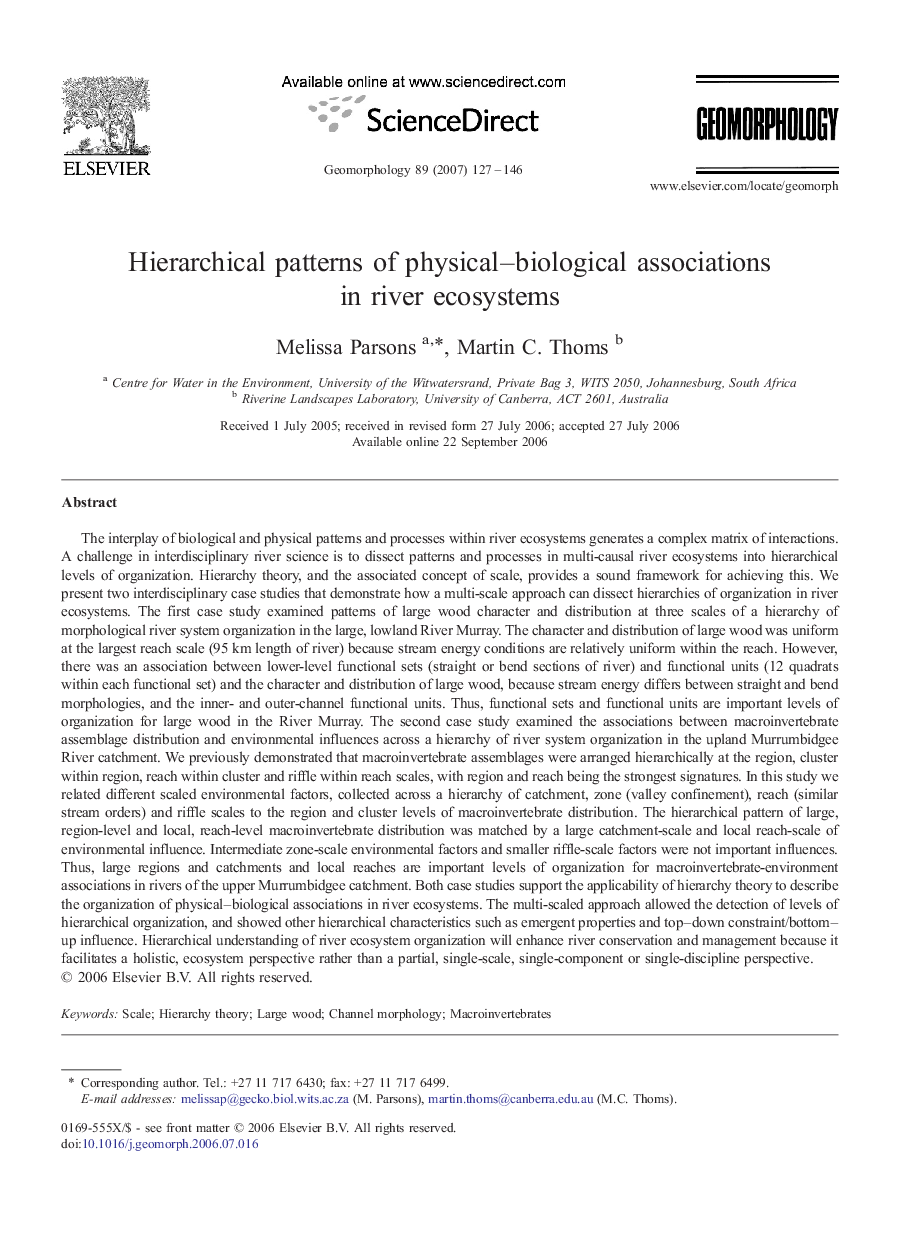| کد مقاله | کد نشریه | سال انتشار | مقاله انگلیسی | نسخه تمام متن |
|---|---|---|---|---|
| 4687242 | 1635575 | 2007 | 20 صفحه PDF | دانلود رایگان |
عنوان انگلیسی مقاله ISI
Hierarchical patterns of physical-biological associations in river ecosystems
دانلود مقاله + سفارش ترجمه
دانلود مقاله ISI انگلیسی
رایگان برای ایرانیان
کلمات کلیدی
موضوعات مرتبط
مهندسی و علوم پایه
علوم زمین و سیارات
فرآیندهای سطح زمین
پیش نمایش صفحه اول مقاله

چکیده انگلیسی
The interplay of biological and physical patterns and processes within river ecosystems generates a complex matrix of interactions. A challenge in interdisciplinary river science is to dissect patterns and processes in multi-causal river ecosystems into hierarchical levels of organization. Hierarchy theory, and the associated concept of scale, provides a sound framework for achieving this. We present two interdisciplinary case studies that demonstrate how a multi-scale approach can dissect hierarchies of organization in river ecosystems. The first case study examined patterns of large wood character and distribution at three scales of a hierarchy of morphological river system organization in the large, lowland River Murray. The character and distribution of large wood was uniform at the largest reach scale (95Â km length of river) because stream energy conditions are relatively uniform within the reach. However, there was an association between lower-level functional sets (straight or bend sections of river) and functional units (12 quadrats within each functional set) and the character and distribution of large wood, because stream energy differs between straight and bend morphologies, and the inner- and outer-channel functional units. Thus, functional sets and functional units are important levels of organization for large wood in the River Murray. The second case study examined the associations between macroinvertebrate assemblage distribution and environmental influences across a hierarchy of river system organization in the upland Murrumbidgee River catchment. We previously demonstrated that macroinvertebrate assemblages were arranged hierarchically at the region, cluster within region, reach within cluster and riffle within reach scales, with region and reach being the strongest signatures. In this study we related different scaled environmental factors, collected across a hierarchy of catchment, zone (valley confinement), reach (similar stream orders) and riffle scales to the region and cluster levels of macroinvertebrate distribution. The hierarchical pattern of large, region-level and local, reach-level macroinvertebrate distribution was matched by a large catchment-scale and local reach-scale of environmental influence. Intermediate zone-scale environmental factors and smaller riffle-scale factors were not important influences. Thus, large regions and catchments and local reaches are important levels of organization for macroinvertebrate-environment associations in rivers of the upper Murrumbidgee catchment. Both case studies support the applicability of hierarchy theory to describe the organization of physical-biological associations in river ecosystems. The multi-scaled approach allowed the detection of levels of hierarchical organization, and showed other hierarchical characteristics such as emergent properties and top-down constraint/bottom-up influence. Hierarchical understanding of river ecosystem organization will enhance river conservation and management because it facilitates a holistic, ecosystem perspective rather than a partial, single-scale, single-component or single-discipline perspective.
ناشر
Database: Elsevier - ScienceDirect (ساینس دایرکت)
Journal: Geomorphology - Volume 89, Issues 1â2, 1 September 2007, Pages 127-146
Journal: Geomorphology - Volume 89, Issues 1â2, 1 September 2007, Pages 127-146
نویسندگان
Melissa Parsons, Martin C. Thoms,